
The Art of Flânerie
Wandering Paris With No Specific Purpose
The flâneur
is someone who strolls as an acute observer of society.
The word entered French from the Old Norse verb flana,
meaning "to wander with no purpose".
Maybe that's how the Norsemen found Canada.
The idea of the activity
flânerie as
strolling or idling dates to the 16th or 17th century,
often referring to wasting time.
But writers in the 19th century developed a rich set of
honorable interpretations of the flâneur
and flânerie.
Charles Augustin Sainte-Beuve contributed
to a long article on the flâneur person
and flânerie activity in the
Grand dictionnaire universel du
XIXe siècle.
He explained that to flâne
"is the very opposite of doing nothing".
In that same article,
Honoré de Balzac described
flânerie as "the gastronomy of the eye".
Anaïs Bazin stated that
"the only, the true sovereign of Paris is the
flâneur".

Victor Fournel, in his 1867 book Ce qu'on voit dans les rues de Paris (or What One Sees in the Streets of Paris) included an entire chapter on "The Art of Flânerie". He saw it not as a form of laziness, but as a way of understanding the variety of city landscape and architecture. It was "un daguerréotype mobile et passioné", or a moving and passionate photograph of the urban experience.
Charles Baudelaire is perhaps associated more than any other writer with the modern explanation of the flâneur. He used the word to denote an artist whose mind is independent, passionate, impartial, "that which the language can only clumsily define."
Baudelaire lived for a while in the Hôtel Pimodan on the Île Saint-Louis in the Seine, just upstream of Île de la Cité. Through the 1700s, the new districts to the west of Paris had become fashionable while the Île Saint-Louis first became declassé and then almost a backwater. He shared an upstairs apartment with the physician and writer Théophile Gautier. They seemed like nice, quiet gentlemen.
The two formed their Club des Hashischins and experimented with hashish along with Victor Hugo, Alexandre Dumas, Honoré de Balzac, Eugène Delacroix, Gérard de Nerval, and other literary and artistic figures. They consumed their hashish dissolved in strong coffee which the members described as looking like a greenish preserve.
Gautier wrote about the club in an article "Le Club des Hashischins" in the February 1846 issue of the Revue des Deux Mondes. Baudelaire wrote the first poems of Les Fleurs du Mal while living there.
Baudelaire also smoked opium, consumed laudanum (a tincture of opium dissolved in alcohol), and drank alcohol in excess, the combination of which led to his death. So, be careful out there.
Baudelaire wrote about the flâneur in "The Painter of Modern Life," published in Le Figaro in 1863 and available in this Penguin Classics edition. In Part III, The artist, man of the world, man of the crowds and child, he wrote:
For the perfect stroller, for the passionate observer, it is an immense enjoyment to choose one's home in numbers, in the undulating, in the movement, in the fugitive and the infinite. Being out of one's home, and yet feeling everywhere at home to see the world, to be at the center of the world and to remain hidden from the world, these are some of the least pleasures of those independent, passionate, impartial minds, which the language can only clumsily define. The observer is a prince who enjoys his incognito everywhere. The lover of life makes the world his family, as the lover of the fair sex composes his family of all the beauties found, findable and untraceable; as the lover of paintings lives in a society enchanted with dreams painted on canvas. So the one in love with universal life enters the crowd as in a huge reservoir of electricity. We can also compare him to a mirror as immense as this crowd; to a kaleidoscope endowed with consciousness, which, at each of its movements, represents the multiple life and moving grace of all the elements of life. It is an insatiable self of the non-self, which, at every moment, renders it and expresses it in images more alive than life itself, always unstable and fleeting.
Amazon
ASIN: 0140446060
Then, in Part IV, Modernity,
So he goes, he runs, he seeks. What is he looking for? Certainly, this man, as I have described it, this loner endowed with an active imagination, always traveling through the great desert of men, has a higher purpose than that of a pure stroller, a goal more general, other than the fleeting pleasure of the circumstance. He is looking for something that we will be able to call modernity; because there is no better word to express the idea in question. For him, it is a question of freeing from fashion what it can contain of poetics in history, to draw the eternal from the transient.
Arriving in Paris
Teaching NATOin Belgium
I had been in Belgium, teaching a cybersecurity course for NATO at SHAPE, Supreme Headquarters Allied Powers Europe, just outside Mons. The small city of Mons is in an economically depressed region once reliant on coal mining. It is no longer a stop for the high-speed Thalys and SNCF trains. I returned to Brussels and bought a Thalys ticket to Paris.

We're on the way!

The high-speed trains from Brussels and beyond arrive at Paris Gare du Nord, along with Eurostar trains from London, and SNCF TGV and Picard TER trains serving northern France. The current station opened in the 1860s.


Gare du Nord is the busiest railway station in Europe, with over 700,000 passengers daily.

I had a bed reserved at the Vintage hostel, a short walk away at 73 rue de Dunkerque. That's its exterior below.


I stored my stuff and was quickly settled into a shared room, no doubt much like Baudelaire's shared apartment. Except with less hashish.
Petite-Flânerie in the 9th Arrondissement
I went out to explore the IXème, the 9th Arrondissement. Maps are available, like this one at the nearby Anvers Métropolitain station. Or you can just wander.

Rue de Dunkerque leads to the base of Montmartre, the hill topped by Basilique Sacré-Cœur.
Montmartre is the highest point in the city. The basilica is a double monument, political and cultural, built from 1875 to 1914 as a national penance for the events of 1870-1871, the war and the commune.
The Franco-Prussian war led to the capture of Emperor Napoleon III and the collapse of the Second French Empire. The Third Republic was established, but with Paris under siege for four months, its capital moved to Tours.


The Paris Commune defended the city. It was a radical socialist and revolutionary government that relied on the National Guard rather than regular Army troops. Paris surrendered, and the new chief executive of the French national government signed an armistice with Prussia disarming the Army but not the National Guard.

On 18 March 1871, soldiers of the Commune killed two French Army generals, and the Commune announced that it did not accept the authority of the French national government. The Commune governed Paris for two months, until it was defeated by regular French Army forces during Le semaine sanglante or "The Bloody Week", beginning 21 May 1871. Montmartre had been the most rebellious neighborhood of the Commune.
Small shops are open in the evening.


I got dinner at Bistro l'Ecrin, seen above, and wandered some more. It was the first week of June, and the sky didn't become fully dark until late in the evening.

Café in the 10th Arrondissement
The next cross street down rue de Dunkerque toward the station is the boundary with the Xème, the 10th arrondissement. The next morning, I went to the corner tabac for a small cup or two of espresso. Just ask for café, espresso is the default.

The tabac is a French institution. Yes, you can still buy tobacco there, but most people stop for coffee, or a small glass of wine or calvados. Then they can examine the racing news in detail, catch up on the football results, or try their luck with a lottery ticket.

I wandered the side streets of the neighborhood before setting off on a longer route.


Look Like Paris?
A machine vision paper by a group from Carnegie Mellon University in Pittsburgh and INRIA / Ecole Normale Supérieure in Paris showed that Paris and many other European cities each have their own distinctive visual style. The style of Paris is based on the windows, railings, and roofs. They presented the paper at the SIGGRAPH conference in 2012.
Below I'm nearing Gare du Nord.

South through the 10th Arrondissement
I continued down rue de Dunkerque past the Gare du Nord, continued to the nearby Gare de l'Est, and turned south on Boulevard de Strausbourg. Several blocks south you come to what once was the outer city wall.
The city wall of Charles V was built from 1356 to 1383, when Paris was much smaller. It was demolished in the 1670s as the city expanded, and some of the Grands Boulevards were built along its path. Louis XIV had the Porte Saint-Martin and Porte Saint-Denis built here to celebrate his military victories. The broad boulevard following the old wall is named Boulevard Saint-Denis to the west, and Boulevard Saint-Martin to the east. Within a few blocks in either direction, it changes names again.


Saint Denis is the patron saint of Paris, thought to have been its first bishop. A basilica in his honor, once well outside the city but now in a northern suburb, is the burial place of most of the French royalty.
Across the boulevard is one of the excellent Gibert Jeune bookstores. I'll cross over and see what they have in the way of bi-lingual detective novels.

Lunch in a Passage
I'll wander a few blocks back to the north, then down one of the many covered passages.
Passage Brady dates from 1825, when the merchants Brady and Briavoine planned a covered passageway with 113 stores with housing above. It ran east-west from rue du Faubourg-Saint-Martin to rue de Faubourg-Saint-Denis. The large Boulevard de Strasbourg, running north-south, was built in 1852 and split the passage in half.


Yes, I'm in France, but the Indian thali looks very good. The flâneur plans neither path nor meals.


After lunch in Passage Brady, Passage du Prado beckons.



Now down rue de Porte Saint-Denis, a smaller street parallel to Boulevard de Strasbourg.
The southern end of rue de Porte Saint-Denis has several Turkish restaurants.

Other parts of the neighborhood around Château d'Eau Métro station are home to people from Francophone Africa.





Café Le Château d'Eau
The Café Le Château d'Eau is a block west of the Métro station by that name, at the corner of rue de Porte Saint-Denis.


I had a Normandy cidre and watched people pass through the neighborhood.

Around Château d'Eau
Budget hotelsin France
There are still budget hotels in France. The Belfort, just across from the café, is one of several examples in the Château d'Eau neighborhood.


A short distance south along rue du Porte-Saint-Denis is a school.
Like so many French schools, it has a memorial to the school children killed by the Nazis and their puppet Vichy government that controlled unoccupied France during the war.
To the memory of the students of this school
deported between 1942 to 1944 because they were Jews,
innocent victims of the barbarism of the Nazis and
the Vichy government.
They were killed in the death camps.
More than 500 of these children lived in the 10th
arrondissement.
We will never forget them.


School Menus
The school, as required by French law, also has its menu posted. There's no lunch on Monday (Lundi) because Saturday through Monday was the Pentecost holiday. School, libraries, and post offices were all closed.
Electricityin France
Yes, Pentecost is a 3-day holiday in France. So much for the theories of Fox "News" watchers who believe that America is the only Christian nation, and that France doesn't have electricity outside the two or three largest cities.
French school meals are both nutrition and cultural education. Salad, vegetables, organically sourced meats and fish, and fruit or yogurt for dessert most days. Pizza and "french-fried" potatoes appear very infrequently, and hamburgers never.

Into a Small Bar
I stopped in a small bar with a view out to the street.

Everyone else was from the neighborhood.

I got out my recent purchases, two examples of roman noir — Dashiell Hammett's "The Gutting of Couffignal" and "Crooked Souls", and Raymond Chandler's "Find the Girl".
French detectives and detective fictionThe Hammett one is the place to start as it's a bilingue, with the original English text and a French translation on facing pages with footnotes explaining the pulp-era jargon. The other is simply a French translation of the Chandler story.
Yes, the French people read Hammett and Chandler in the original to work on their English. Impressive!

Passage du Ponceau
Back out onto the street, continuing roughly south for the most part. Passage du Ponceau led off through one block.




Continuing South through the 2nd Arrondissement
I had soon crossed into the IIème. This is an école maternelle, a pre-school or nursery school for children aged 3 to 5. In 2018 the école maternelle became compulsory for all children aged 3. But before that law, almost all children ages 3 through 5 were already attending.


The sign here explains that 140 children of the IIème were killed in the Nazi death camps, "innocent victims of the Nazi barbarism with the complicity of the Vichy government."
The pre-school menu is also healthy. The children learn about nutrition and social behavior during their meals.



Further south is the Passage Bourg l'Abbe.


And the Passage du Grand Cerf.

Entering the 1st Arrondissement
The Ième is at the heart of ancient Paris, it includes the Île de la Cité in the Seine. The arrondissements are said to be laid out like a snail, their numbers spiraling out counterclockwise from the Ième.


The Hôtel de Ville is along the right bank of the Seine. That is, the City Hall. Hôtel only very recently came to mean a business where you could rent a room to stay overnight. A hôtel particulier used to be a large urban home, often the in-town home of nobility who usually stayed in their château or castle in the countryside. A hôtel-Dieu or "House of God" was a hospital, the Hôtel des Invalides was a hospice for wounded veterans. It's much like what has happened with the word inn in English.

To the Islands in the Seine
I'm crossing from the Right Bank to Île de la Cité, at the right. That's Île Saint-Louis just upstream in the middle of the Seine.


From the upstream tip of Île de la Cité I see the Left Bank on my right as I'm looking upstream. Île Saint-Louis where Baudelaire lived, is in the middle of the Seine.

Île de la Cité has a very moving memorial for the deportation of Jews to prison camps in France, and then east to the death camps.




I was there less than two months after the fire of April 2019 that destroyed the spire and most of the roof of Cathédrale Notre-Dame.


Back to the Marais
MaraisAfter a short walk along the Left Bank, I crossed back over the Seine to the Marais district and joined other flâneurs at Les Étages.

Some recent writers have proposed the term flâneuse to refer to the female flâneur.


Back to the 9th
I made my way back to the IXème for another late dinner at Bistro l'Ecrin


And then back to the hostel for further rehydration with Orangina. Opium probably wouldn't dissolve well in a highly polar liquid such as Orangina, a high concentration of ethanol would be needed. But Baudelaire and the Club des Hashischins would have found some use for Orangina. No doubt as a solvent for hashish.
Amazon
ASIN: B005CWJKAW
Amazon
ASIN: 0415089131

Morphine, the primary biologically active component of opium.




